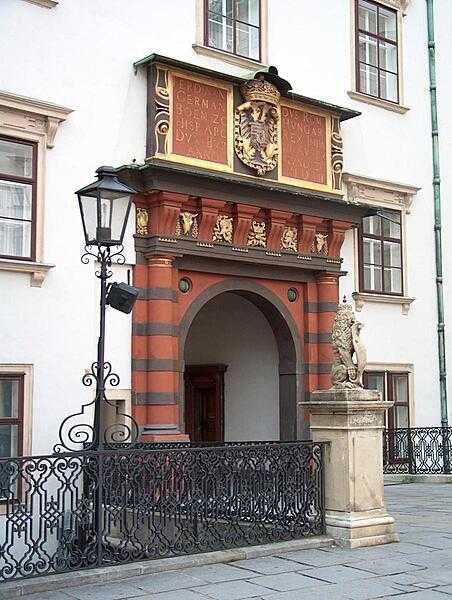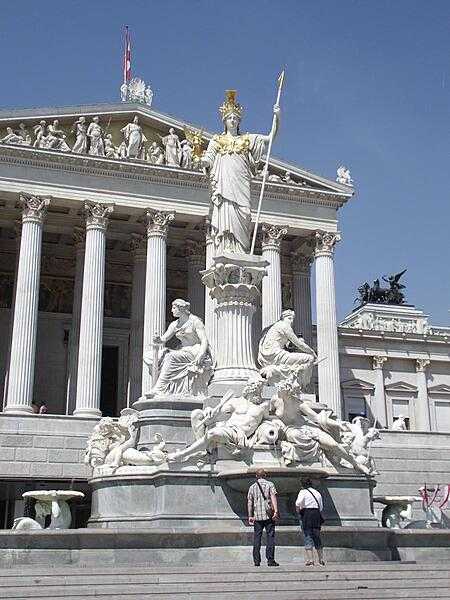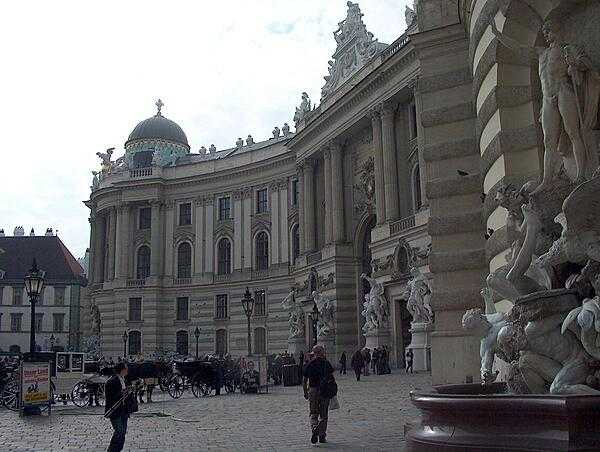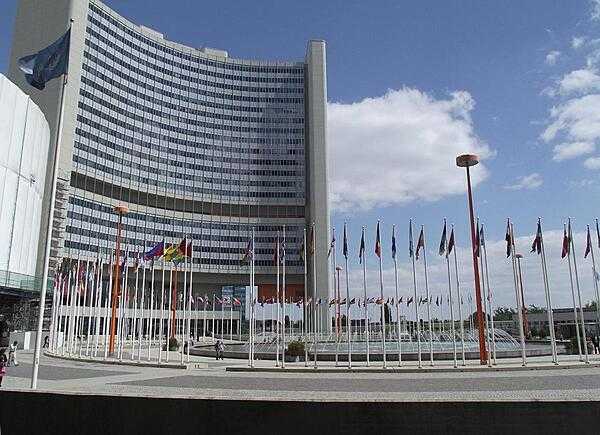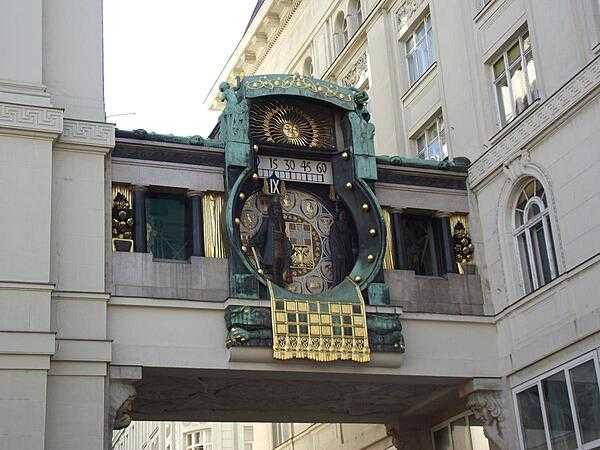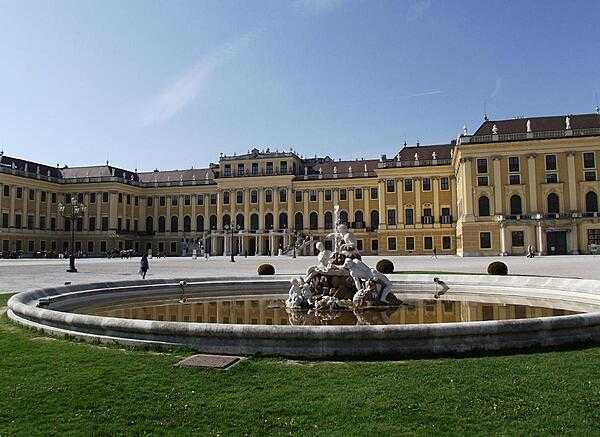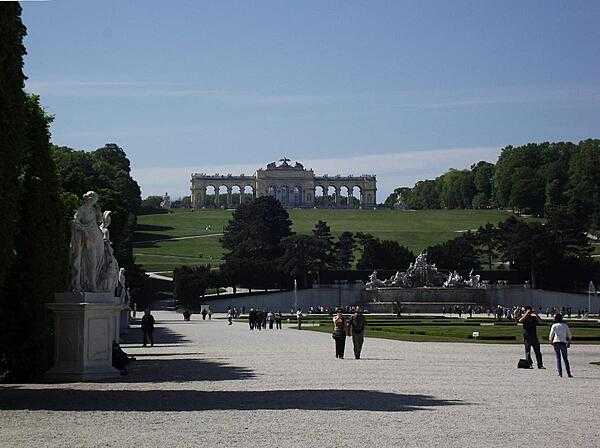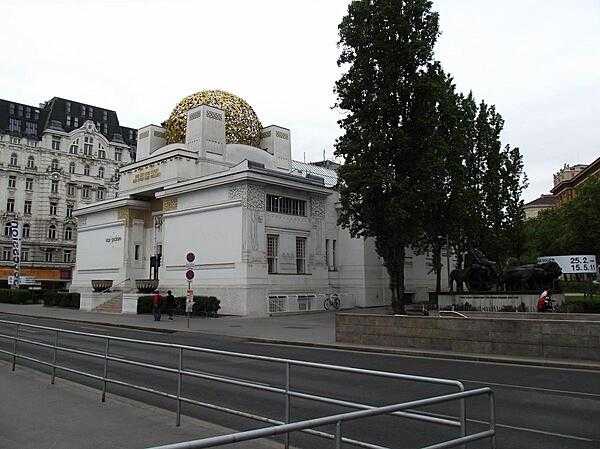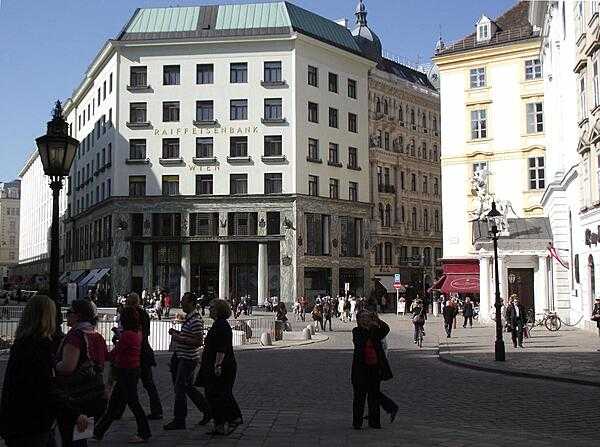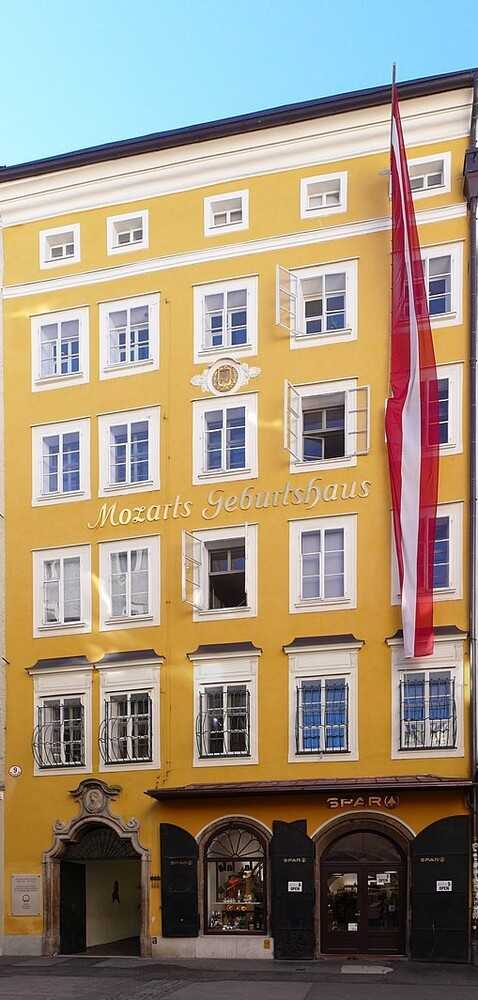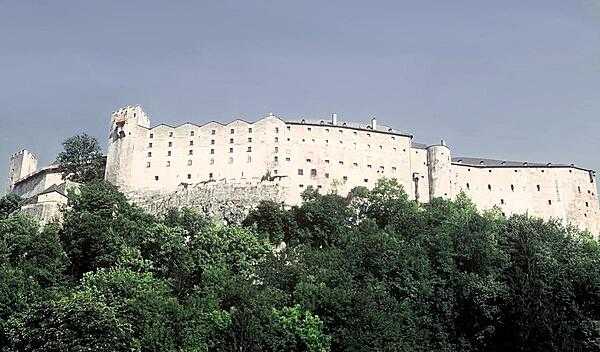Austria - AT - AUT - AUT - Europe
Last updated: December 09, 2025
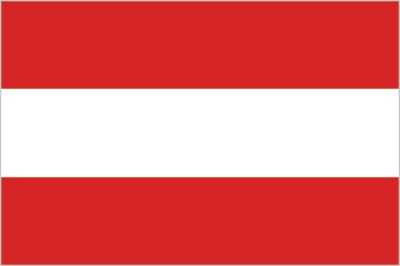
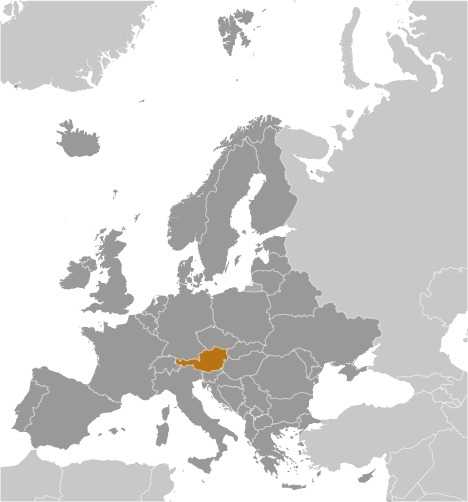
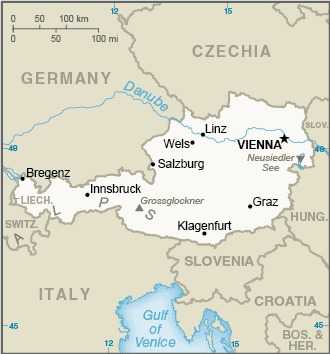
Austria Images
Austria Factbook Data
Diplomatic representation from the US
chief of mission: Ambassador Art FISHER (since 19 November 2025)
embassy: Boltzmanngasse 16, 1090, Vienna
mailing address: 9900 Vienna Place, Washington DC 20521-9900
telephone: [43] (1) 31339 0
FAX: [43] (1) 31339 2017
email address and website:
ConsulateVienna@state.gov
https://at.usembassy.gov/
embassy: Boltzmanngasse 16, 1090, Vienna
mailing address: 9900 Vienna Place, Washington DC 20521-9900
telephone: [43] (1) 31339 0
FAX: [43] (1) 31339 2017
email address and website:
ConsulateVienna@state.gov
https://at.usembassy.gov/
Age structure
0-14 years: 14.1% (male 648,639/female 616,334)
15-64 years: 64.7% (male 2,904,587/female 2,898,339)
65 years and over: 21.2% (2024 est.) (male 839,672/female 1,060,411)
15-64 years: 64.7% (male 2,904,587/female 2,898,339)
65 years and over: 21.2% (2024 est.) (male 839,672/female 1,060,411)

This is the population pyramid for Austria. A population pyramid illustrates the age and sex structure of a country's population and may provide insights about political and social stability, as well as economic development. The population is distributed along the horizontal axis, with males shown on the left and females on the right. The male and female populations are broken down into 5-year age groups represented as horizontal bars along the vertical axis, with the youngest age groups at the bottom and the oldest at the top. The shape of the population pyramid gradually evolves over time based on fertility, mortality, and international migration trends.
For additional information, please see the entry for Population pyramid on the Definitions and Notes page.
For additional information, please see the entry for Population pyramid on the Definitions and Notes page.
Geographic coordinates
47 20 N, 13 20 E
Sex ratio
at birth: 1.05 male(s)/female
0-14 years: 1.05 male(s)/female
15-64 years: 1 male(s)/female
65 years and over: 0.79 male(s)/female
total population: 0.96 male(s)/female (2024 est.)
0-14 years: 1.05 male(s)/female
15-64 years: 1 male(s)/female
65 years and over: 0.79 male(s)/female
total population: 0.96 male(s)/female (2024 est.)
Natural hazards
landslides; avalanches; earthquakes
Area - comparative
about the size of South Carolina; slightly more than two-thirds the size of Pennsylvania
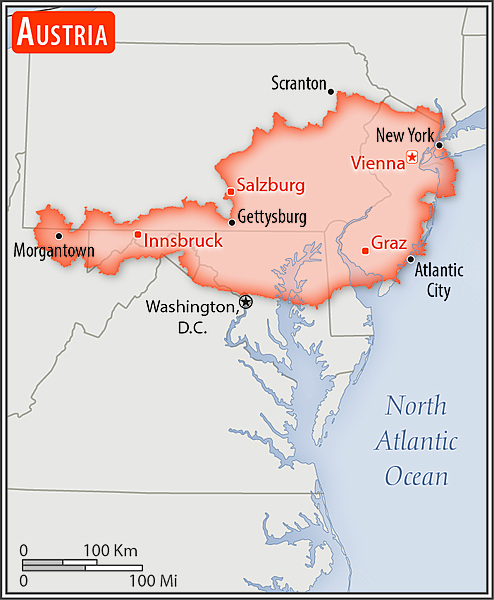
about the size of South Carolina; slightly more than two-thirds the size of Pennsylvania
Military service age and obligation
registration requirement at age 17, the legal minimum age for voluntary military service; men above the age of 18 are subject to compulsory military service; women may volunteer; compulsory service is for 6 months, or optionally, alternative civil/community service (Zivildienst) for 9 months (2024)
note 1: as of 2023, women made up about 4% of the military's full-time personnel
note 2: in a January 2013 referendum, a majority of Austrians voted in favor of retaining the system of compulsory military service (with the option of alternative/non-military service) instead of switching to a professional army system
note 1: as of 2023, women made up about 4% of the military's full-time personnel
note 2: in a January 2013 referendum, a majority of Austrians voted in favor of retaining the system of compulsory military service (with the option of alternative/non-military service) instead of switching to a professional army system
Background
Once the center of power for the large Austro-Hungarian Empire, Austria was reduced to a small republic after its defeat in World War I. Nazi Germany annexed Austria in 1938, and the victorious Allies then occupied the country in 1945. As a result, Austria's status remained unclear for a decade after World War II, until a State Treaty signed in 1955 ended the occupation, recognized Austria's independence, and forbade unification with Germany. A constitutional law that same year declared the country's "perpetual neutrality" as a condition for Soviet military withdrawal. Austria joined the EU in 1995, but the obligation to remain neutral kept it from joining NATO, although the country became a member of NATO's Partnership for Peace program in 1995. Austria entered the EU Economic and Monetary Union in 1999.
Environmental issues
some forest degradation from air and soil pollution; soil pollution from agricultural chemicals; air pollution from coal- and oil-fired power stations and industrial plants, and from trucks transiting Austria; water pollution
International environmental agreements
party to: Air Pollution, Air Pollution-Heavy Metals, Air Pollution-Nitrogen Oxides, Air Pollution-Persistent Organic Pollutants, Air Pollution-Sulphur 85, Air Pollution-Sulphur 94, Air Pollution-Volatile Organic Compounds, Antarctic Treaty, Biodiversity, Climate Change, Climate Change-Kyoto Protocol, Climate Change-Paris Agreement, Comprehensive Nuclear Test Ban, Desertification, Endangered Species, Environmental Modification, Hazardous Wastes, Law of the Sea, Nuclear Test Ban, Ozone Layer Protection, Ship Pollution, Tropical Timber 2006, Wetlands, Whaling
signed, but not ratified: Air Pollution-Multi-effect Protocol, Antarctic-Environmental Protection
signed, but not ratified: Air Pollution-Multi-effect Protocol, Antarctic-Environmental Protection
Military expenditures
1% of GDP (2024 est.)
0.9% of GDP (2023 est.)
0.7% of GDP (2022 est.)
0.8% of GDP (2021 est.)
0.7% of GDP (2020 est.)
0.9% of GDP (2023 est.)
0.7% of GDP (2022 est.)
0.8% of GDP (2021 est.)
0.7% of GDP (2020 est.)
Population below poverty line
14.8% (2021 est.)
note: % of population with income below national poverty line
note: % of population with income below national poverty line
Household income or consumption by percentage share
lowest 10%: 2.8% (2022 est.)
highest 10%: 24.6% (2022 est.)
note: % share of income accruing to lowest and highest 10% of population
highest 10%: 24.6% (2022 est.)
note: % share of income accruing to lowest and highest 10% of population
Exports - commodities
cars, packaged medicine, vaccines, vehicle parts/accessories, nitrogen compounds (2023)
note: top five export commodities based on value in dollars
note: top five export commodities based on value in dollars
Exports - partners
Germany 25%, USA 9%, Italy 7%, Switzerland 5%, Hungary 4% (2023)
note: top five export partners based on percentage share of exports
note: top five export partners based on percentage share of exports
Administrative divisions
9 states (Bundeslaender, singular - Bundesland); Burgenland, Kaernten (Carinthia), Niederoesterreich (Lower Austria), Oberoesterreich (Upper Austria), Salzburg, Steiermark (Styria), Tirol (Tyrol), Vorarlberg, Wien (Vienna)
Agricultural products
milk, sugar beets, maize, wheat, barley, potatoes, pork, grapes, triticale, soybeans (2023)
note: top ten agricultural products based on tonnage
note: top ten agricultural products based on tonnage
Military and security forces
Austrian Armed Forces (Bundesheer): Land Forces, Air Force, Cyber Forces, Special Operations Forces, Militia (reserves) (2025)
note 1: the federal police maintain internal security and report to the Ministry of the Interior
note 2: the militia is comprised of men and women who have done their basic military or training service and continue to perform a task in the armed forces; they are integrated into the military but have civilian jobs and only participate in exercises or operations; missions for the militia may include providing disaster relief, assisting security police, and protecting critical infrastructure (energy, water, etc.), as well as deployments on missions abroad
note 1: the federal police maintain internal security and report to the Ministry of the Interior
note 2: the militia is comprised of men and women who have done their basic military or training service and continue to perform a task in the armed forces; they are integrated into the military but have civilian jobs and only participate in exercises or operations; missions for the militia may include providing disaster relief, assisting security police, and protecting critical infrastructure (energy, water, etc.), as well as deployments on missions abroad
Budget
revenues: $231.132 billion (2023 est.)
expenditures: $241.516 billion (2023 est.)
note: central government revenues (excluding grants) and expenditures converted to US dollars at average official exchange rate for year indicated
expenditures: $241.516 billion (2023 est.)
note: central government revenues (excluding grants) and expenditures converted to US dollars at average official exchange rate for year indicated
Capital
name: Vienna
geographic coordinates: 48 12 N, 16 22 E
time difference: UTC+1 (6 hours ahead of Washington, DC, during Standard Time)
daylight saving time: +1hr, begins last Sunday in March; ends last Sunday in October
etymology: the name may have evolved from the Roman name Vindobona, which was taken from the Celtic words vindo (white) and bona (fort)
geographic coordinates: 48 12 N, 16 22 E
time difference: UTC+1 (6 hours ahead of Washington, DC, during Standard Time)
daylight saving time: +1hr, begins last Sunday in March; ends last Sunday in October
etymology: the name may have evolved from the Roman name Vindobona, which was taken from the Celtic words vindo (white) and bona (fort)
Imports - commodities
cars, garments, vaccines, vehicle parts/accessories, refined petroleum (2023)
note: top five import commodities based on value in dollars
note: top five import commodities based on value in dollars
Climate
temperate; continental, cloudy; cold winters with frequent rain and some snow in lowlands and snow in mountains; moderate summers with occasional showers
Coastline
0 km (landlocked)
Constitution
history: several previous; latest adopted 1 October 1920, revised 1929, replaced May 1934, replaced by German Weimar constitution in 1938 following German annexation, reinstated 1 May 1945
amendment process: proposed through laws designated "constitutional laws" or through the constitutional process if the amendment is part of another law; approval required by at least a two-thirds majority vote by the National Assembly and the presence of one-half of the members; a referendum is required only if requested by one-third of the National Council or Federal Council membership; passage by referendum requires absolute majority vote
amendment process: proposed through laws designated "constitutional laws" or through the constitutional process if the amendment is part of another law; approval required by at least a two-thirds majority vote by the National Assembly and the presence of one-half of the members; a referendum is required only if requested by one-third of the National Council or Federal Council membership; passage by referendum requires absolute majority vote
Exchange rates
euros (EUR) per US dollar -
Exchange rates:
0.924 (2024 est.)
0.925 (2023 est.)
0.95 (2022 est.)
0.845 (2021 est.)
0.876 (2020 est.)
Exchange rates:
0.924 (2024 est.)
0.925 (2023 est.)
0.95 (2022 est.)
0.845 (2021 est.)
0.876 (2020 est.)
Executive branch
chief of state: President Alexander VAN DER BELLEN (since 26 January 2017)
head of government: Chancellor Christian STOCKER (since 3 March 2025)
cabinet: Council of Ministers proposed by the chancellor and appointed by the president
election/appointment process: president directly elected by absolute-majority popular vote in 2 rounds, if needed, for a 6-year term (eligible for a second term); chancellor appointed by the president but determined by the majority coalition parties in the Federal Assembly; vice chancellor appointed by the president on the advice of the chancellor
most recent election date: 9 October 2022
election results:
2022: Alexander VAN DER BELLEN reelected in first round; percent of vote - Alexander VAN DER BELLEN (independent) 56.7%, Walter ROSENKRANZ (FPO) 17.7%, Dominik WLAZNY (Beer Party) 8.3%, Tassilo WALLENTIN (independent) 8.1%, Gerald GROSZ (independent) 5.6%
2016: Alexander VAN DER BELLEN elected in second round; percent of vote in first round - Norbert HOFER (FPOe) 35.1%, Alexander VAN DER BELLEN (independent, allied with the Greens) 21.3%, Irmgard GRISS (independent) 18.9%, Rudolf HUNDSTORFER (SPOe) 11.3%, Andreas KHOL (OeVP) 11.1%, Richard LUGNER (independent) 2.3%; percent of vote in second round - Alexander VAN DER BELLEN 53.8%, Norbert HOFER 46.2%
expected date of next election: 2028
head of government: Chancellor Christian STOCKER (since 3 March 2025)
cabinet: Council of Ministers proposed by the chancellor and appointed by the president
election/appointment process: president directly elected by absolute-majority popular vote in 2 rounds, if needed, for a 6-year term (eligible for a second term); chancellor appointed by the president but determined by the majority coalition parties in the Federal Assembly; vice chancellor appointed by the president on the advice of the chancellor
most recent election date: 9 October 2022
election results:
2022: Alexander VAN DER BELLEN reelected in first round; percent of vote - Alexander VAN DER BELLEN (independent) 56.7%, Walter ROSENKRANZ (FPO) 17.7%, Dominik WLAZNY (Beer Party) 8.3%, Tassilo WALLENTIN (independent) 8.1%, Gerald GROSZ (independent) 5.6%
2016: Alexander VAN DER BELLEN elected in second round; percent of vote in first round - Norbert HOFER (FPOe) 35.1%, Alexander VAN DER BELLEN (independent, allied with the Greens) 21.3%, Irmgard GRISS (independent) 18.9%, Rudolf HUNDSTORFER (SPOe) 11.3%, Andreas KHOL (OeVP) 11.1%, Richard LUGNER (independent) 2.3%; percent of vote in second round - Alexander VAN DER BELLEN 53.8%, Norbert HOFER 46.2%
expected date of next election: 2028
Flag
description: three equal horizontal bands of red (top), white, and red
history: one of the oldest national flags in the world; according to tradition, after a fierce battle in the Third Crusade in 1191, Duke Leopold V of Austria's white tunic became blood-spattered; when his sash was removed, a white band was revealed, and the red-white-red color combination was adopted as his banner
history: one of the oldest national flags in the world; according to tradition, after a fierce battle in the Third Crusade in 1191, Duke Leopold V of Austria's white tunic became blood-spattered; when his sash was removed, a white band was revealed, and the red-white-red color combination was adopted as his banner
Independence
no official date of independence: 976 (Margravate of Austria established); 17 September 1156 (Duchy of Austria founded); 6 January 1453 (Archduchy of Austria acknowledged); 11 August 1804 (Austrian Empire proclaimed); 30 March 1867 (Austro-Hungarian dual monarchy established); 12 November 1918 (First Republic proclaimed); 27 April 1945 (Second Republic proclaimed)
Industries
construction, machinery, vehicles and parts, food, metals, chemicals, lumber and paper, electronics, tourism
Judicial branch
highest court(s): Supreme Court of Justice or Oberster Gerichtshof (consists of 85 judges organized into 17 senates or panels of 5 judges each); Constitutional Court or Verfassungsgerichtshof (consists of 20 judges including 6 substitutes; Administrative Court or Verwaltungsgerichtshof - 2 judges plus other members depending on the importance of the case)
judge selection and term of office: Supreme Court judges nominated by executive branch departments and appointed by the president; judges serve for life; Constitutional Court judges nominated by several executive branch departments and approved by the president; judges serve for life; Administrative Court judges recommended by executive branch departments and appointed by the president; terms of judges and members determined by the president
subordinate courts: Courts of Appeal (4); Regional Courts (20); district courts (120); county courts
judge selection and term of office: Supreme Court judges nominated by executive branch departments and appointed by the president; judges serve for life; Constitutional Court judges nominated by several executive branch departments and approved by the president; judges serve for life; Administrative Court judges recommended by executive branch departments and appointed by the president; terms of judges and members determined by the president
subordinate courts: Courts of Appeal (4); Regional Courts (20); district courts (120); county courts
Land boundaries
total: 2,524 km
border countries (8): Czech Republic 402 km; Germany 801 km; Hungary 321 km; Italy 404 km; Liechtenstein 34 km; Slovakia 105 km; Slovenia 299 km; Switzerland 158 km
border countries (8): Czech Republic 402 km; Germany 801 km; Hungary 321 km; Italy 404 km; Liechtenstein 34 km; Slovakia 105 km; Slovenia 299 km; Switzerland 158 km
Legal system
civil law system; Constitutional Court reviews legislative acts
Legislative branch
legislature name: Parliament (Parlament)
legislative structure: bicameral
legislative structure: bicameral
Maritime claims
none (landlocked)
International organization participation
ADB (nonregional member), AfDB (nonregional member), Australia Group, BIS, BSEC (observer), CD, CE, CEI, CERN, EAPC, EBRD, ECB, EIB, EMU, ESA, EU, FAO, FATF, G-9, IADB, IAEA, IBRD, ICAO, ICC (national committees), ICCt, ICRM, IDA, IEA, IFAD, IFC, IFRCS, IGAD (partners), ILO, IMF, IMO, Interpol, IOC, IOM, IPU, ISO, ITSO, ITU, ITUC (NGOs), MIGA, MINURSO, NEA, NSG, OAS (observer), OECD, OIF (observer), OPCW, OSCE, Paris Club, PCA, PFP, Schengen Convention, SELEC (observer), UN, UNCTAD, UNESCO, UNFICYP, UNHCR, UNIDO, UNIFIL, UNTSO, UNWTO, UPU, Wassenaar Arrangement, WCO, WFTU (NGOs), WHO, WIPO, WMO, WTO, ZC
National holiday
National Day (commemorates passage of the law on permanent neutrality), 26 October (1955)
Nationality
noun: Austrian(s)
adjective: Austrian
adjective: Austrian
Natural resources
oil, coal, lignite, timber, iron ore, copper, zinc, antimony, magnesite, tungsten, graphite, salt, hydropower
Geography - note
note 1: landlocked; strategic location at the crossroads of central Europe with many easily traversable Alpine passes and valleys; major river is the Danube; population is concentrated on eastern lowlands because of steep slopes, poor soils, and low temperatures elsewhere
note 2: the world's largest and longest ice cave system at 42 km (26 mi) is the Eisriesenwelt (Ice Giants World) inside the Hochkogel mountain near Werfen, about 40 km south of Salzburg; ice caves are bedrock caves that contain year-round ice formations; they differ from glacial caves, which are transient and are formed by melting ice and flowing water within and under glaciers
note 2: the world's largest and longest ice cave system at 42 km (26 mi) is the Eisriesenwelt (Ice Giants World) inside the Hochkogel mountain near Werfen, about 40 km south of Salzburg; ice caves are bedrock caves that contain year-round ice formations; they differ from glacial caves, which are transient and are formed by melting ice and flowing water within and under glaciers
Economic overview
one of the strongest EU and euro economies; diversified trade portfolios and relations; enormous trade economy; Russian energy dependence, but investing in alternative energy; aging labor force but large refugee population; large government debt
Political parties
Austrian People's Party or OeVP
Freedom Party of Austria or FPOe
The Greens - The Green Alternative
NEOS - The New Austria and Liberal Forum
Social Democratic Party of Austria or SPOe
Freedom Party of Austria or FPOe
The Greens - The Green Alternative
NEOS - The New Austria and Liberal Forum
Social Democratic Party of Austria or SPOe
Railways
total: 6,123 km (2022) 3,523 km electrified
Suffrage
16 years of age; universal
Terrain
mostly mountains (Alps) in the west and south; mostly flat or gently sloping along the eastern and northern margins
Government type
federal parliamentary republic
Country name
conventional long form: Republic of Austria
conventional short form: Austria
local long form: Republik Oesterreich
local short form: Oesterreich
etymology: the name Oesterreich means "eastern realm" and dates to the 10th century; the designation refers to the fact that Austria was the easternmost extension of Bavaria and the German peoples; the word Austria is a Latinization of the German name
conventional short form: Austria
local long form: Republik Oesterreich
local short form: Oesterreich
etymology: the name Oesterreich means "eastern realm" and dates to the 10th century; the designation refers to the fact that Austria was the easternmost extension of Bavaria and the German peoples; the word Austria is a Latinization of the German name
Location
Central Europe, north of Italy and Slovenia
Map references
Europe
Irrigated land
382 sq km (2016)
Diplomatic representation in the US
chief of mission: Ambassador Petra SCHNEEBAUER (since 19 APRIL 2023)
chancery: 3524 International Court NW, Washington, DC 20008-3035
telephone: [1] (202) 895-6700
FAX: [1] (202) 895-6750
email address and website:
washington-ob@bmeia.gv.at
https://www.austria.org/
consulate(s) general: Los Angeles, New York
consulate(s): Chicago
chancery: 3524 International Court NW, Washington, DC 20008-3035
telephone: [1] (202) 895-6700
FAX: [1] (202) 895-6750
email address and website:
washington-ob@bmeia.gv.at
https://www.austria.org/
consulate(s) general: Los Angeles, New York
consulate(s): Chicago
Internet users
percent of population: 95% (2024 est.)
Internet country code
.at
Refugees and internally displaced persons
refugees: 313,711 (2024 est.)
stateless persons: 3,919 (2024 est.)
stateless persons: 3,919 (2024 est.)
GDP (official exchange rate)
$521.642 billion (2024 est.)
note: data in current dollars at official exchange rate
note: data in current dollars at official exchange rate
Total renewable water resources
77.7 billion cubic meters (2022 est.)
School life expectancy (primary to tertiary education)
total: 16 years (2023 est.)
male: 16 years (2023 est.)
female: 17 years (2023 est.)
male: 16 years (2023 est.)
female: 17 years (2023 est.)
Urbanization
urban population: 59.5% of total population (2023)
rate of urbanization: 0.68% annual rate of change (2020-25 est.)
rate of urbanization: 0.68% annual rate of change (2020-25 est.)
Broadcast media
public broadcaster, Oesterreichischer Rundfunk (ORF), is a major player in the TV and radio markets; private broadcasters, cable, and satellite TV are available in most homes are widely used; some German stations carry programs for Austrian viewers; national and regional newspapers compete fiercely for readers; the print media are owned by a handful of mostly Austrian and German media groups (2023)
Drinking water source
improved:
urban: 100% of population (2022 est.)
rural: 100% of population (2022 est.)
total: 100% of population (2022 est.)
unimproved:
urban: 0% of population (2022 est.)
rural: 0% of population (2022 est.)
total: 0% of population (2022 est.)
urban: 100% of population (2022 est.)
rural: 100% of population (2022 est.)
total: 100% of population (2022 est.)
unimproved:
urban: 0% of population (2022 est.)
rural: 0% of population (2022 est.)
total: 0% of population (2022 est.)
National anthem(s)
title: "Bundeshymne" (Federal Hymn)
lyrics/music: Paula von PRERADOVIC/Wolfgang Amadeus MOZART or Johann HOLZER (disputed)
history: adopted 1947; Austria adopted a new national anthem after World War II to replace the former imperial anthem composed by Franz Josef HAYDN, which Germany had appropriated in 1922 and was thereafter associated with the Nazi regime; the Austrian Federal Assembly adopted a gender-neutral version of the lyrics in 2012
note: the beloved waltz "The Blue Danube" ("An der schoenen, blauen Donau"), composed in 1866 by Johann STRAUSS II, is widely considered Austria's unofficial national anthem
lyrics/music: Paula von PRERADOVIC/Wolfgang Amadeus MOZART or Johann HOLZER (disputed)
history: adopted 1947; Austria adopted a new national anthem after World War II to replace the former imperial anthem composed by Franz Josef HAYDN, which Germany had appropriated in 1922 and was thereafter associated with the Nazi regime; the Austrian Federal Assembly adopted a gender-neutral version of the lyrics in 2012
note: the beloved waltz "The Blue Danube" ("An der schoenen, blauen Donau"), composed in 1866 by Johann STRAUSS II, is widely considered Austria's unofficial national anthem
This is an audio of the National Anthem for Austria. The national anthem is generally a patriotic musical composition - usually in the form of a song or hymn of praise - that evokes and eulogizes the history, traditions, or struggles of a nation or its people. National anthems can be officially recognized as a national song by a country's constitution or by an enacted law, or simply by tradition. Although most anthems contain lyrics, some do not.
Major urban areas - population
1.975 million VIENNA (capital) (2023)
International law organization participation
accepts compulsory ICJ jurisdiction; accepts ICCt jurisdiction
Physician density
5.52 physicians/1,000 population (2023)
Hospital bed density
7.1 beds/1,000 population (2020 est.)
National symbol(s)
eagle, edelweiss, Alpine gentian
Mother's mean age at first birth
29.7 years (2020 est.)
GDP - composition, by end use
household consumption: 52.2% (2023 est.)
government consumption: 20.5% (2023 est.)
investment in fixed capital: 24.9% (2023 est.)
investment in inventories: 0.5% (2023 est.)
exports of goods and services: 59.5% (2023 est.)
imports of goods and services: -57.3% (2023 est.)
note: figures may not total 100% due to rounding or gaps in data collection
government consumption: 20.5% (2023 est.)
investment in fixed capital: 24.9% (2023 est.)
investment in inventories: 0.5% (2023 est.)
exports of goods and services: 59.5% (2023 est.)
imports of goods and services: -57.3% (2023 est.)
note: figures may not total 100% due to rounding or gaps in data collection
Dependency ratios
total dependency ratio: 53.4 (2024 est.)
youth dependency ratio: 21.7 (2024 est.)
elderly dependency ratio: 31.7 (2024 est.)
potential support ratio: 3.2 (2024 est.)
youth dependency ratio: 21.7 (2024 est.)
elderly dependency ratio: 31.7 (2024 est.)
potential support ratio: 3.2 (2024 est.)
Citizenship
citizenship by birth: no
citizenship by descent only: at least one parent must be a citizen of Austria
dual citizenship recognized: no
residency requirement for naturalization: 10 years
citizenship by descent only: at least one parent must be a citizen of Austria
dual citizenship recognized: no
residency requirement for naturalization: 10 years
Population distribution
the northern and eastern portions of the country are more densely populated; nearly two thirds of the populace lives in urban areas
Electricity access
electrification - total population: 100% (2022 est.)
Civil aircraft registration country code prefix
OE
Sanitation facility access
improved:
urban: 100% of population (2022 est.)
rural: 100% of population (2022 est.)
total: 100% of population (2022 est.)
unimproved:
urban: 0% of population (2022 est.)
rural: 0% of population (2022 est.)
total: 0% of population (2022 est.)
urban: 100% of population (2022 est.)
rural: 100% of population (2022 est.)
total: 100% of population (2022 est.)
unimproved:
urban: 0% of population (2022 est.)
rural: 0% of population (2022 est.)
total: 0% of population (2022 est.)
Ethnic groups
Austrian 80.8%, German 2.6%, Bosnian and Herzegovinian 1.9%, Turkish 1.8%, Serbian 1.6%, Romanian 1.3%, other 10% (2018 est.)
note: data represent population by country of birth
note: data represent population by country of birth
Religions
Roman Catholic 55.2%, Muslim 8.3%, Orthodox 4.9%, Evangelical Christian 3.8%, Jewish 0.1%, other 5.4%, none 22.4% (2021 est.)
note: data on Muslim is a 2016 estimate; data on other/none/unspecified are from 2012-2018 estimates
note: data on Muslim is a 2016 estimate; data on other/none/unspecified are from 2012-2018 estimates
Languages
German (official nationwide) 88.6%, Turkish 2.3%, Serbian 2.2%, Croatian (official in Burgenland) 1.6%, other (includes Slovene, official in southern Carinthia, and Hungarian, official in Burgenland) 5.3% (2001 est.)
major-language sample(s):
Das World Factbook, die unverzichtbare Quelle für grundlegende Informationen. (German)
The World Factbook, the indispensable source for basic information.
major-language sample(s):
Das World Factbook, die unverzichtbare Quelle für grundlegende Informationen. (German)
The World Factbook, the indispensable source for basic information.
German audio sample
Imports - partners
Germany 34%, China 7%, Italy 7%, Switzerland 5%, Czechia 4% (2023)
note: top five import partners based on percentage share of imports
note: top five import partners based on percentage share of imports
Elevation
highest point: Grossglockner 3,798 m
lowest point: Neusiedler See 115 m
mean elevation: 910 m
lowest point: Neusiedler See 115 m
mean elevation: 910 m
Health expenditure
12.1% of GDP (2021)
16.3% of national budget (2022 est.)
16.3% of national budget (2022 est.)
Military and security service personnel strengths
approximately 22,000 active Armed Forces (includes about 14,000 regular troops and around 8,000 reservists/militia undergoing refresher training) (2025)
Military equipment inventories and acquisitions
the military's inventory includes a mix of domestically produced and imported weapons systems from European countries and the US; the Austrian defense industry produces a range of equipment and partners with other countries (2024)
Terrorist group(s)
Terrorist group(s): Islamic State of Iraq and ash-Sham (ISIS)
note: details about the history, aims, leadership, organization, areas of operation, tactics, targets, weapons, size, and sources of support of the group(s) appear(s) in the Terrorism reference guide
note: details about the history, aims, leadership, organization, areas of operation, tactics, targets, weapons, size, and sources of support of the group(s) appear(s) in the Terrorism reference guide
Total water withdrawal
municipal: 34.36 million cubic meters (2022 est.)
industrial: 2.21 billion cubic meters (2022 est.)
agricultural: 124 million cubic meters (2022 est.)
industrial: 2.21 billion cubic meters (2022 est.)
agricultural: 124 million cubic meters (2022 est.)
Waste and recycling
municipal solid waste generated annually: 5.22 million tons (2024 est.)
percent of municipal solid waste recycled: 36% (2022 est.)
percent of municipal solid waste recycled: 36% (2022 est.)
Average household expenditures
on food: 10.1% of household expenditures (2023 est.)
on alcohol and tobacco: 3.5% of household expenditures (2023 est.)
on alcohol and tobacco: 3.5% of household expenditures (2023 est.)
National heritage
total World Heritage Sites: 12 (11 cultural, 1 natural)
selected World Heritage Site locales: Historic Salzburg (c); Palace and Gardens of Schönbrunn (c); Halstadt–Dachstein/Salzkammergut Cultural Landscape (c); Semmering railway (c); Historic Graz and Schloss Eggenberg (c); Wachau Cultural Landscape (c); Historic Vienna (c); Fertő/Neusiedlersee Cultural Landscape (c); Baden bei Wien (c); Primeval Beech Forests - Dürrenstein, Kalkalpen (n)
selected World Heritage Site locales: Historic Salzburg (c); Palace and Gardens of Schönbrunn (c); Halstadt–Dachstein/Salzkammergut Cultural Landscape (c); Semmering railway (c); Historic Graz and Schloss Eggenberg (c); Wachau Cultural Landscape (c); Historic Vienna (c); Fertő/Neusiedlersee Cultural Landscape (c); Baden bei Wien (c); Primeval Beech Forests - Dürrenstein, Kalkalpen (n)
Major watersheds (area sq km)
Atlantic Ocean drainage: Rhine-Maas (198,735 sq km), (Black Sea) Danube (795,656 sq km)
Military - note
the military’s primary responsibilities are national defense and protecting Austria’s neutrality; it also has some domestic security and disaster response responsibilities; each of the nine federal states has a military command that provides a link between the military and civil authorities; the main tasks of these commands include providing military assistance during disasters and supporting security police operations
the Austrian military contributes to international peacekeeping and humanitarian missions; Austria has been constitutionally militarily non-aligned since 1955 but is an EU member and actively participates in EU peacekeeping and crisis management operations under the EU Common Security and Defense Policy; Austria is not a member of NATO but joined NATO’s Partnership for Peace framework in 1995 and participates in some NATO-led crisis management and peacekeeping operations; more than 100,000 Austrian military and civilian personnel have taken part in more than 50 international peace support and humanitarian missions since 1960 (2025)
the Austrian military contributes to international peacekeeping and humanitarian missions; Austria has been constitutionally militarily non-aligned since 1955 but is an EU member and actively participates in EU peacekeeping and crisis management operations under the EU Common Security and Defense Policy; Austria is not a member of NATO but joined NATO’s Partnership for Peace framework in 1995 and participates in some NATO-led crisis management and peacekeeping operations; more than 100,000 Austrian military and civilian personnel have taken part in more than 50 international peace support and humanitarian missions since 1960 (2025)
Major lakes (area sq km)
fresh water lake(s): Lake Constance (shared with Switzerland and Germany) - 540 sq km
Major rivers (by length in km)
Donau (Danube) (shared with Germany [s], Slovakia, Hungary, Croatia, Serbia, Bulgaria, Ukraine, Moldova, and Romania [m]) - 2,888 km
note: [s] after country name indicates river source; [m] after country name indicates river mouth
note: [s] after country name indicates river source; [m] after country name indicates river mouth
Coal
production: 1.288 million metric tons (2023 est.)
consumption: 5.403 million metric tons (2023 est.)
exports: 2,000 metric tons (2022 est.)
imports: 4.179 million metric tons (2023 est.)
consumption: 5.403 million metric tons (2023 est.)
exports: 2,000 metric tons (2022 est.)
imports: 4.179 million metric tons (2023 est.)
Electricity generation sources
fossil fuels: 14.9% of total installed capacity (2023 est.)
solar: 9% of total installed capacity (2023 est.)
wind: 11.9% of total installed capacity (2023 est.)
hydroelectricity: 56.4% of total installed capacity (2023 est.)
biomass and waste: 7.8% of total installed capacity (2023 est.)
solar: 9% of total installed capacity (2023 est.)
wind: 11.9% of total installed capacity (2023 est.)
hydroelectricity: 56.4% of total installed capacity (2023 est.)
biomass and waste: 7.8% of total installed capacity (2023 est.)
Natural gas
production: 548.976 million cubic meters (2023 est.)
consumption: 6.971 billion cubic meters (2023 est.)
imports: 7.084 billion cubic meters (2023 est.)
proven reserves: 5.04 billion cubic meters (2021 est.)
consumption: 6.971 billion cubic meters (2023 est.)
imports: 7.084 billion cubic meters (2023 est.)
proven reserves: 5.04 billion cubic meters (2021 est.)
Petroleum
total petroleum production: 18,000 bbl/day (2023 est.)
refined petroleum consumption: 244,000 bbl/day (2024 est.)
crude oil estimated reserves: 35.2 million barrels (2021 est.)
refined petroleum consumption: 244,000 bbl/day (2024 est.)
crude oil estimated reserves: 35.2 million barrels (2021 est.)
Gross reproduction rate
0.74 (2024 est.)
Currently married women (ages 15-49)
58.7% (2023 est.)
Remittances
0.7% of GDP (2024 est.)
0.6% of GDP (2023 est.)
0.6% of GDP (2022 est.)
note: personal transfers and compensation between resident and non-resident individuals/households/entities
0.6% of GDP (2023 est.)
0.6% of GDP (2022 est.)
note: personal transfers and compensation between resident and non-resident individuals/households/entities
Space agency/agencies
Aeronautics and Space Agency (ALR; established in 1972 as the Austrian Space Agency) (2025)
Geoparks
total global geoparks and regional networks: 3
global geoparks and regional networks: Ore of the Alps; Styrian Eisenwurzen; Karawanken/Karavanke (includes Slovenia) (2023)
global geoparks and regional networks: Ore of the Alps; Styrian Eisenwurzen; Karawanken/Karavanke (includes Slovenia) (2023)
Legislative branch - upper chamber
chamber name: Federal Council (Bundesrat)
number of seats: 60 (all indirectly elected)
parties elected and seats per party: People's Party (OVP) (22); Social Democratic Party (SPO) (18); Freedom Party (16); Greens (3); NEOS (New Austria) (1)
percentage of women in chamber: 46.7%
number of seats: 60 (all indirectly elected)
parties elected and seats per party: People's Party (OVP) (22); Social Democratic Party (SPO) (18); Freedom Party (16); Greens (3); NEOS (New Austria) (1)
percentage of women in chamber: 46.7%
National color(s)
red, white
Particulate matter emissions
10.3 micrograms per cubic meter (2019 est.)
Labor force
4.768 million (2024 est.)
note: number of people ages 15 or older who are employed or seeking work
note: number of people ages 15 or older who are employed or seeking work
Youth unemployment rate (ages 15-24)
total: 11.7% (2024 est.)
male: 11.4% (2024 est.)
female: 12% (2024 est.)
note: % of labor force ages 15-24 seeking employment
male: 11.4% (2024 est.)
female: 12% (2024 est.)
note: % of labor force ages 15-24 seeking employment
Net migration rate
3.5 migrant(s)/1,000 population (2024 est.)
Median age
total: 44.9 years (2024 est.)
male: 43.6 years
female: 46.3 years
male: 43.6 years
female: 46.3 years
Maternal mortality ratio
6 deaths/100,000 live births (2023 est.)
Reserves of foreign exchange and gold
$35.406 billion (2024 est.)
$31.212 billion (2023 est.)
$33.078 billion (2022 est.)
note: holdings of gold (year-end prices)/foreign exchange/special drawing rights in current dollars
$31.212 billion (2023 est.)
$33.078 billion (2022 est.)
note: holdings of gold (year-end prices)/foreign exchange/special drawing rights in current dollars
Public debt
78.3% of GDP (2023 est.)
note: central government debt as a % of GDP
note: central government debt as a % of GDP
Total fertility rate
1.52 children born/woman (2024 est.)
Unemployment rate
5.5% (2024 est.)
5.3% (2023 est.)
5% (2022 est.)
note: % of labor force seeking employment
5.3% (2023 est.)
5% (2022 est.)
note: % of labor force seeking employment
Population
total: 8,967,982 (2024 est.)
male: 4,392,898
female: 4,575,084
male: 4,392,898
female: 4,575,084
Carbon dioxide emissions
56.959 million metric tonnes of CO2 (2023 est.)
from coal and metallurgical coke: 10.527 million metric tonnes of CO2 (2023 est.)
from petroleum and other liquids: 33.036 million metric tonnes of CO2 (2023 est.)
from consumed natural gas: 13.397 million metric tonnes of CO2 (2023 est.)
from coal and metallurgical coke: 10.527 million metric tonnes of CO2 (2023 est.)
from petroleum and other liquids: 33.036 million metric tonnes of CO2 (2023 est.)
from consumed natural gas: 13.397 million metric tonnes of CO2 (2023 est.)
Area
total : 83,871 sq km
land: 82,445 sq km
water: 1,426 sq km
land: 82,445 sq km
water: 1,426 sq km
Taxes and other revenues
25.9% (of GDP) (2023 est.)
note: central government tax revenue as a % of GDP
note: central government tax revenue as a % of GDP
Real GDP (purchasing power parity)
$581.131 billion (2024 est.)
$588.031 billion (2023 est.)
$593.701 billion (2022 est.)
note: data in 2021 dollars
$588.031 billion (2023 est.)
$593.701 billion (2022 est.)
note: data in 2021 dollars
Airports
62 (2025)
Infant mortality rate
total: 3.2 deaths/1,000 live births (2024 est.)
male: 3.6 deaths/1,000 live births
female: 2.7 deaths/1,000 live births
male: 3.6 deaths/1,000 live births
female: 2.7 deaths/1,000 live births
Telephones - mobile cellular
total subscriptions: 11.1 million (2023 est.)
subscriptions per 100 inhabitants: 123 (2022 est.)
subscriptions per 100 inhabitants: 123 (2022 est.)
Gini Index coefficient - distribution of family income
30.9 (2022 est.)
note: index (0-100) of income distribution; higher values represent greater inequality
note: index (0-100) of income distribution; higher values represent greater inequality
Inflation rate (consumer prices)
2.9% (2024 est.)
7.8% (2023 est.)
8.5% (2022 est.)
note: annual % change based on consumer prices
7.8% (2023 est.)
8.5% (2022 est.)
note: annual % change based on consumer prices
Current account balance
$12.642 billion (2024 est.)
$6.783 billion (2023 est.)
-$3.911 billion (2022 est.)
note: balance of payments - net trade and primary/secondary income in current dollars
$6.783 billion (2023 est.)
-$3.911 billion (2022 est.)
note: balance of payments - net trade and primary/secondary income in current dollars
Real GDP per capita
$63,300 (2024 est.)
$64,400 (2023 est.)
$65,700 (2022 est.)
note: data in 2021 dollars
$64,400 (2023 est.)
$65,700 (2022 est.)
note: data in 2021 dollars
Broadband - fixed subscriptions
total: 2.71 million (2023 est.)
subscriptions per 100 inhabitants: 30 (2023 est.)
subscriptions per 100 inhabitants: 30 (2023 est.)
Tobacco use
total: 19.7% (2025 est.)
male: 21.1% (2025 est.)
female: 18.3% (2025 est.)
male: 21.1% (2025 est.)
female: 18.3% (2025 est.)
Obesity - adult prevalence rate
20.1% (2016)
Energy consumption per capita
120.211 million Btu/person (2023 est.)
Death rate
9.9 deaths/1,000 population (2024 est.)
Birth rate
9.3 births/1,000 population (2024 est.)
Electricity
installed generating capacity: 33.371 million kW (2023 est.)
consumption: 64.611 billion kWh (2023 est.)
exports: 21.631 billion kWh (2023 est.)
imports: 21.55 billion kWh (2023 est.)
transmission/distribution losses: 3.095 billion kWh (2023 est.)
consumption: 64.611 billion kWh (2023 est.)
exports: 21.631 billion kWh (2023 est.)
imports: 21.55 billion kWh (2023 est.)
transmission/distribution losses: 3.095 billion kWh (2023 est.)
Merchant marine
total: 1 (2023)
by type: other 1
by type: other 1
Imports
$284.467 billion (2024 est.)
$293.692 billion (2023 est.)
$294.324 billion (2022 est.)
note: balance of payments - imports of goods and services in current dollars
$293.692 billion (2023 est.)
$294.324 billion (2022 est.)
note: balance of payments - imports of goods and services in current dollars
Exports
$299.366 billion (2024 est.)
$303.914 billion (2023 est.)
$291.804 billion (2022 est.)
note: balance of payments - exports of goods and services in current dollars
$303.914 billion (2023 est.)
$291.804 billion (2022 est.)
note: balance of payments - exports of goods and services in current dollars
Heliports
112 (2025)
Telephones - fixed lines
total subscriptions: 3.604 million (2023 est.)
subscriptions per 100 inhabitants: 40 (2023 est.)
subscriptions per 100 inhabitants: 40 (2023 est.)
Alcohol consumption per capita
total: 11.9 liters of pure alcohol (2019 est.)
beer: 6.3 liters of pure alcohol (2019 est.)
wine: 3.7 liters of pure alcohol (2019 est.)
spirits: 1.9 liters of pure alcohol (2019 est.)
other alcohols: 0 liters of pure alcohol (2019 est.)
beer: 6.3 liters of pure alcohol (2019 est.)
wine: 3.7 liters of pure alcohol (2019 est.)
spirits: 1.9 liters of pure alcohol (2019 est.)
other alcohols: 0 liters of pure alcohol (2019 est.)
Life expectancy at birth
total population: 82.7 years (2024 est.)
male: 80.1 years
female: 85.4 years
male: 80.1 years
female: 85.4 years
Real GDP growth rate
-1.2% (2024 est.)
-1% (2023 est.)
5.3% (2022 est.)
note: annual GDP % growth based on constant local currency
-1% (2023 est.)
5.3% (2022 est.)
note: annual GDP % growth based on constant local currency
Industrial production growth rate
-5.5% (2024 est.)
note: annual % change in industrial value added based on constant local currency
note: annual % change in industrial value added based on constant local currency
GDP - composition, by sector of origin
agriculture: 1.2% (2024 est.)
industry: 23.1% (2024 est.)
services: 65.3% (2024 est.)
note: figures may not total 100% due to non-allocated consumption not captured in sector-reported data
industry: 23.1% (2024 est.)
services: 65.3% (2024 est.)
note: figures may not total 100% due to non-allocated consumption not captured in sector-reported data
Population growth rate
0.3% (2024 est.)
Legislative branch - lower chamber
chamber name: National Council (Nationalrat)
number of seats: 183 (all directly elected)
electoral system: proportional representation
scope of elections: full renewal
term in office: 5 years
most recent election date: 9/29/2024
parties elected and seats per party: Freedom Party (FPÖ) (57); People's Party (ÖVP) (51); Social Democratic Party (SPÖ) (41); NEOS (“New Austria”) (18); Greens (16)
percentage of women in chamber: 35.5%
expected date of next election: September 2029
number of seats: 183 (all directly elected)
electoral system: proportional representation
scope of elections: full renewal
term in office: 5 years
most recent election date: 9/29/2024
parties elected and seats per party: Freedom Party (FPÖ) (57); People's Party (ÖVP) (51); Social Democratic Party (SPÖ) (41); NEOS (“New Austria”) (18); Greens (16)
percentage of women in chamber: 35.5%
expected date of next election: September 2029
Land use
agricultural land: 31.5% (2023 est.)
arable land: 16% (2023 est.)
permanent crops: 0.8% (2023 est.)
permanent pasture: 14.7% (2023 est.)
forest: 47.2% (2023 est.)
other: 20.9% (2023 est.)
arable land: 16% (2023 est.)
permanent crops: 0.8% (2023 est.)
permanent pasture: 14.7% (2023 est.)
forest: 47.2% (2023 est.)
other: 20.9% (2023 est.)
Space program overview
established a national space program in 2002; develops, builds, operates, and tracks satellites, including remote sensing and research/scientific satellites; member of the ESA; works closely with ESA and EU member states and the commercial sector to develop a range of space capabilities and technologies, including applications for satellite payloads, space flight, and space research; participates in a range of ESA/EU programs, including Space Surveillance and Tracking (SST), Copernicus Earth observation, and Galileo global navigation satellite system; also cooperates with other foreign space agencies and industries, including those of China, India, Russia, and the US (2025)
Military deployments
210 Bosnia-Herzegovina (EUFOR stabilization force); 100 Kosovo (NATO/KFOR); 160 Lebanon (UNIFIL) (2025)
Key space-program milestones
1981 - became an associate ESA member (full member in 1987)
1991 - first Austrian in space on Soviet Mir Space Station
2013 - first domestically built science/technology (star observation) satellites (TUGSAT-1 and UniBRITE) launched by India
2017 - worked with China to produce world’s first quantum-encrypted satellite communications teleconference from Beijing to Vienna
2024 - signed US-led Artemis Accords outlining best practices for cooperative space exploration
1991 - first Austrian in space on Soviet Mir Space Station
2013 - first domestically built science/technology (star observation) satellites (TUGSAT-1 and UniBRITE) launched by India
2017 - worked with China to produce world’s first quantum-encrypted satellite communications teleconference from Beijing to Vienna
2024 - signed US-led Artemis Accords outlining best practices for cooperative space exploration
Education expenditure
5.3% of GDP (2022 est.)
9.9% national budget (2022 est.)
9.9% national budget (2022 est.)

